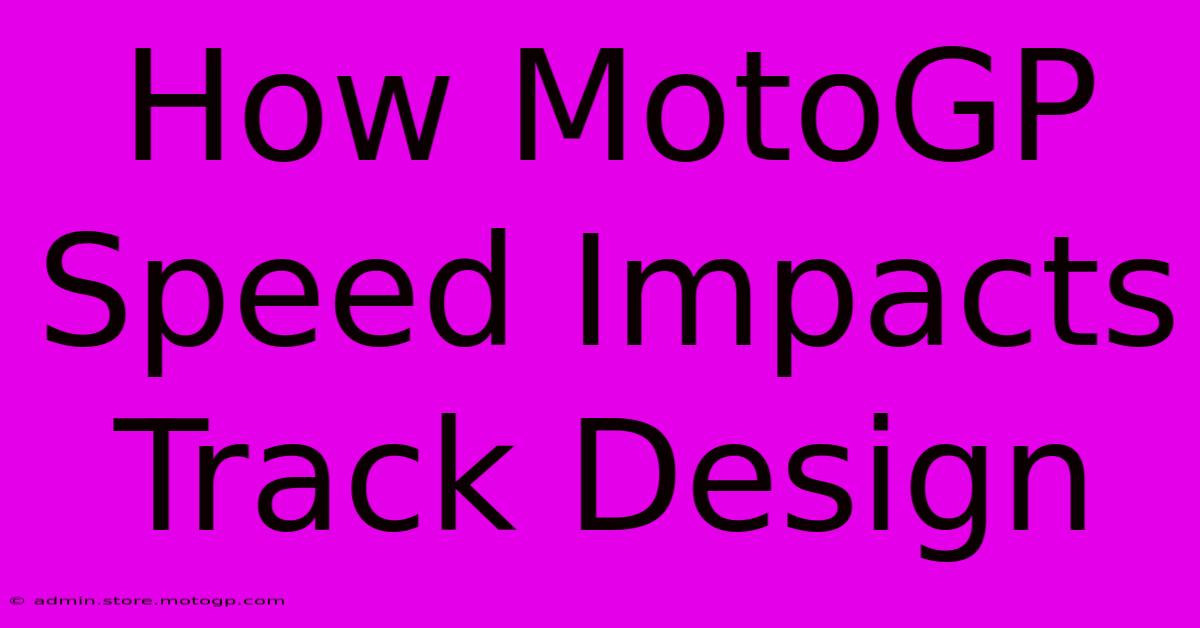How MotoGP Speed Impacts Track Design

Table of Contents
How MotoGP Speed Impacts Track Design
MotoGP, the pinnacle of motorcycle road racing, demands tracks that are both thrilling for spectators and challenging for riders. The sheer speed of these machines directly influences every aspect of track design, from the radius of corners to the length of straights and the elevation changes. Let's delve into how this high-velocity sport shapes the very circuits it calls home.
The Importance of High-Speed Cornering
The breathtaking speeds achieved in MotoGP necessitate careful consideration of corner design. Track designers must balance several crucial factors:
Radius and Banking:
- Larger Radius Corners: To accommodate the immense speeds, many corners feature a larger radius than those found in other racing disciplines. This allows riders to maintain higher speeds throughout the turn, minimizing the need for excessive braking and potentially dangerous deceleration.
- Banking (Superelevation): Banking, or the tilting of the track surface, is crucial for high-speed corners. It helps counteract centrifugal force, allowing riders to lean less and maintain higher cornering speeds while reducing tire wear and the risk of accidents. The degree of banking varies depending on the corner's speed and radius.
Run-off Areas:
- Extensive Run-off Areas: Given the potential for high-speed crashes, MotoGP tracks require significantly larger and more extensive run-off areas compared to other motorsports. These areas, often composed of gravel traps or asphalt run-offs, are designed to slow down errant bikes and protect riders in the event of an incident. The safety of the rider is paramount in modern track design.
Straight Section Considerations
The straights in a MotoGP circuit aren't simply stretches of tarmac; they are integral parts of the overall racing strategy. Here's how speed dictates their design:
Length and Positioning:
- Strategic Placement: The placement and length of straights are carefully planned to create overtaking opportunities. Long straights allow for faster speeds and potential passing maneuvers, while shorter straights may lead to more intense braking and cornering challenges.
- Optimal Length: The length needs to be balanced. Too short, and there's limited overtaking potential; too long and it might create a safety hazard if something goes wrong at high speeds.
Braking Zones:
- Defined Braking Zones: At the end of each straight, designated braking zones are essential. These sections must provide sufficient distance for riders to safely decelerate before entering the next corner. The design here often involves a gentle incline and high levels of grip for maximum braking efficiency.
Elevation Changes and Track Flow
Modern MotoGP tracks often incorporate elevation changes to add another layer of complexity and excitement.
Elevation Changes and Cornering:
- Blind Corners: The use of elevation changes, particularly blind crests and dips, can enhance the challenge for riders and create unpredictable racing moments. These sections require precise bike control and confidence at high speeds.
- Track Flow: Elevation changes, when incorporated skillfully, can significantly improve track flow. This seamless transition between corners and straights enhances the racing experience and allows for smoother racing lines.
The Future of MotoGP Track Design
As MotoGP bikes continue to improve in speed and technology, track designers must constantly adapt. This means:
- Further Safety Improvements: Enhanced run-off areas, improved barriers, and possibly even the incorporation of additional safety technologies are continually being assessed.
- Focus on Overtaking: The pursuit of improved overtaking opportunities is ongoing. Design innovations to increase passing points without compromising safety remain a key area of focus.
- Sustainable Design: Incorporating environmentally conscious practices into track construction is becoming increasingly important.
In conclusion, the incredible speed of MotoGP bikes fundamentally dictates the design of the tracks where they race. Every curve, straight, and elevation change is carefully considered to create a thrilling spectacle while prioritizing the safety of the riders. The constant evolution of both bikes and safety technology ensures the ongoing adaptation of track design to meet the demands of this exhilarating sport.

Thank you for visiting our website wich cover about How MotoGP Speed Impacts Track Design. We hope the information provided has been useful to you. Feel free to contact us if you have any questions or need further assistance. See you next time and dont miss to bookmark.
Featured Posts
-
Formula 1 Parking Made Simple Book Your Pass Now
Feb 20, 2025
-
Moto Gp Helmets The Mark Of A True Racer
Feb 20, 2025
-
Witness The Drama Of Defeat Tnt Moto Gp
Feb 20, 2025
-
Moto2 Specifications The Heart Of A Racing Motorcycle
Feb 20, 2025
-
Moto Gp Crash Today Relive The Incident
Feb 20, 2025
